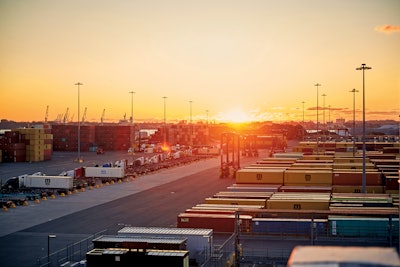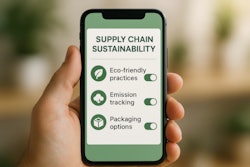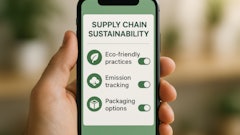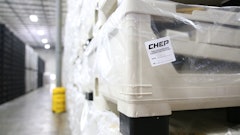
Amid trade volatility and economic uncertainty, ports continue to advance their decarbonization efforts. Replacing diesel with low-emissions equipment and vehicles not only improves air quality for workers and the surrounding community, but helps ports stay ahead of tightening emissions regulations.
A mainstay energy source for material handling, propane remains a uniquely effective solution, enabling meaningful reductions in emissions while keeping operations efficient and cost-effective.
Two ports on opposite sides of the Unite States trust propane to power their day-to-day operations. Fueling everything from terminal tractors and forklifts to backup shore power generation, propane is moving ports like these toward near-zero emissions, delivering both environmental gains and dependable day-to-day performance.
Lower emissions with propane
Historically, ports have been major sources of harmful emissions like nitrogen oxides (NOx), particulate matter (PM), and carbon dioxide (CO₂) due to the prevalence of diesel-powered material handling equipment as well as heavy traffic from cargo ships. For terminal tractors and forklifts, propane offers a significantly cleaner alternative. Propane is non-toxic, doesn't contaminate soil or water, and is recognized as an alternative fuel under the Clean Air Act.
Today’s low-NOx propane engines are up to 90% cleaner than EPA standards, and on average, emit up to 96% fewer NOx emissions than diesel while producing near-zero particulate matter. This cleaner profile is particularly beneficial to the communities close to ports where air quality is a top concern.
Both ports have seen significant improvements after adopting propane-powered equipment. One replaced 40 diesel terminal tractors with propane models and saw a 99% reduction in NOx composite and idle emissions, and 77.5% reduction in hydrocarbon idle emissions. They also saw a 14% decrease in CO₂ emissions, and particulate matter emissions reduced to almost undetectable levels. The other port began transitioning to propane terminal tractors over 20 years ago, and has seen its fleet grow to more than 150 propane terminal tractors. The newer tractors are cleaner and more efficient than ever.
Reduced fuel costs
As businesses face uncertain economic times, switching to propane isn't just a sound environmental decision—it helps fleets lower costs, especially within their fuel budget. On a per-gallon basis, propane can cost up to 50% less than diesel, and because the majority of U.S. supply is produced domestically, the price of propane is more stable and less affected by global oil prices and trade disruptions.
Propane-powered engines also reduce maintenance costs because they don’t require diesel exhaust fluid (DEF) or particulate filters that diesel engines now require, eliminating parts and labor costs as well as downtime from equipment being serviced. Likewise, propane refueling infrastructure can be installed at relatively low costs and scaled to meet the specific needs of a port. Large operations can store over 100,000 gallons of propane onsite, and many propane suppliers will even help cover the cost of infrastructure in exchange for a fuel contract.
These advantages helped both ports retire diesel equipment cost-effectively, meaning they were able to decarbonize faster than if they had chosen another alternative energy source.
Versatility advantages
Propane's broad utility extends far beyond just terminal tractors. It powers a variety of equipment and more, helping ports decarbonize across various areas of their operation.
Terminal tractors. Terminal tractors are essential to port logistics, moving heavy shipping containers around the terminal. One of the most advanced propane-powered models is equipped with an 8.8-liter engine. With 270 horsepower and 565-foot pounds of torque, the tractor meets both ports’ strenuous demands while reducing emissions, and the engine meets a stringent emissions standard of 0.2 grams of NOx and hydrocarbons per brake horsepower-hour.
Forklifts, Propane-powered forklifts have been a trusted choice in port material handling for many years—and for good reason. Compared to diesel, propane-powered forklifts produce 94% fewer hydrocarbon and NOx emissions, as well as 16% fewer greenhouse gases than gasoline models. Additionally, the NOx emissions from propane forklifts are often less than half the total lifecycle NOx emissions of electric forklifts powered by coal-powered electric grids.
Microgrids. Beyond terminal tractors and forklifts, ports are also turning to propane-powered microgrids to strengthen their energy reliability. These propane generator-powered systems can work independently from the main grid or help supplement it during periods of peak demand, and they can also be used for a variety of applications around the port. Electricity from propane microgrids can deliver shore power to docked ships, allowing them to maintain essential operations without relying on their onboard diesel engines.
Beyond auxiliary power for ships, propane microgrids can also support port buildings and infrastructure, maintaining critical systems so the port can stay operational, as well as reducing transmission losses by an average of 5%. This is particularly important as the United States struggles with aging electrical grid infrastructure, increasing demand for power in urban areas, and severe weather that continues to threaten to disrupt power.
A robust decarbonization solution
Propane is a great tool for ports looking to lower their emissions without sacrificing reliability or their bottom lines. From ultra-low emissions port tractors and forklifts to shore power and microgrids, propane can help ports decarbonize without missing a step.




















